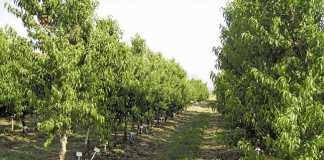In the Western Cape, wheat is traditionally broadcast or sown in 170mm wide rows at recommended planting densities of 100kg to 140kg of seed per hectare. These sowing methods were inappropriate for producers who wanted to change to more sustainable conservation production systems, such as crop rotation and no-till systems, in which- stubble is retained and the seedbed prepared during the planting process.
No-till planters equipped with knife-point openers are now commonly used in the conservation production system in this region. To achieve sufficient seed flow through the planter, it’s a given that no-till planters must use row widths wider than the 170mm that was formerly used, and that seeding density must be adapted accordingly.
Since 2002, the ARC Small Grain Institute conducted research to address these issues and to develop new -recommendations. These recommendations are now finalised and being presented to the wheat producers in this region.
Row widths
The row width of a planter is usually set when the planter is manufactured, and cannot easily be changed during the course of the planting season. Therefore, a decision on the row width must be taken before the start of the season, after considering the advantages and disadvantages of all the options. No-till planters are currently produced with 250mm, 275mm or 300mm row width options. Generally, the wider row width option has the following advantages: lower input and capital costs, which includes fuel, maintenance and initial buying price; reduced risk regarding the use of pre-emergence herbicides and faster planting speed; more efficient seed flow; and increased competition with weeds in the row, especially herbicide resistant grasses.
Unfortunately the use of the wider row option could also have various disadvantages, such as less competition with weeds between rows, especially in poor seasons when sunlight can enter between rows, and problems during the pick-up process in widely spaced rows if the crop is swathed. Research findings from 20 trials over five seasons indicated that the use of the wider row width option (300mm versus 250mm) did not necessarily lead to a negative yield response, but that significant yield loss can occur under certain conditions. In four of the 20 trials (Caledon 2004 and 2006, Napkei valley 2006 and Moorreesburg 2004), significant yield reductions were measured with the use of 300mm versus 250mm row widths.
Interactions between cultivars, row widths and planting density in Hopefield during 2004 and 2005 indicated that cultivars might react differently to planting density and row widths in this region. When yield loss occurs, it’s usually in the order of 200kg/ha, which can constitute a loss of 5% to 10% at yield levels of 2 tons/ha to 4 tons/ha.
Row widths, not wider than 300mm, will give acceptable results in most seasons and in most production areas, but the risk of yield loss due to the use of the wider row option cannot be excluded. The Swartland and especially the Sandveld are more sensitive to the use of wider row widths.
Row width recommendations
The choice of the row width option (250mm, 275mm or 300mm) is left to the producer, after considering the advantages of the wider row width option in relation to the risk in his specific area. Requirements with regards to swathing and planting speed when pre-emergence herbicides are used, must also be considered. A row width of 275mm in the Swartland and Sandveld seems to be a good compromise between safety of applying herbicides, planting speed and reduction of risk of yield loss. Row widths greater than 300mm do not serve any purpose and are not recommended in this region.
Planting density
- New recommendations regarding planting density are based on five seasons’ data, collected within conservation tillage and crop rotation systems in different production areas of the Western Cape. These recommendations require lower planting densities than recommended by conventional planting methods, and are made with the following prerequisites:
- The planter used is specifically designed to plant effectively through stubble left on the surface by the conservation tillage or crop rotation system.
- Seed survival of 80% or better is easily obtainable with the planter.
- Row widths of 250mm to 300mm are used.
- Cultivars with above-average tillering ability are used.
- Good-quality seed with known germination percentage is used.
- Sufficient soil water should be available during planting time.
- Early planting dates, well within the optimal planting time, are used.
- A positive outlook on rainfall during the season is expected.
- Fertiliser is placed accurately with the majority of fertiliser placed safely away from the seed. Not more than 15kg of nitrogen per hectare should be placed in close proximity of the seed to reduce the risk of fertiliser burn.
- Safe application of registered pre-emergence herbicides.
- Good control over herbicide-resistant grasses through the crop rotation system and other practices.
- Pests that are able to reduce seedling survival, such as slugs and isopods, are not present in large numbers.
If it’s not possible to conform to these prerequisites, the producer should stick to the planting densities as recommended for the cultivar. These planting density recommendations include a large safety factor and will ensure sufficient seedling survival in almost all conditions. If the producer plans a reduced planting density and conditions deteriorate during the planting season, the planting density should be increased to cater for these conditions.
The recommendations for lower seeding density are linked to target plants per square metre. The necessary conversion to kilograms per hectare must be made by taking into account the Thousand Kernel Mass (TKM) for the cultivar to be planted.
Planting density recommendations
Planting densities for wheat under the above-mentioned prerequisites are given in Table 1. Producers can significantly save on costs by using these recommendations and managing planting density more precisely.
However, lower planting densities, as recommended here, increase the risk of achieving an unacceptably low plant population if external factors which affect seedling survival and tillering ability play an overriding role during the growing season.
If any uncertainty exists, producers must opt for the seeding rates recommended by the owner of the cultivar to be planted.
Contact John Tolmay on (058) 307 3422. The financial support of the ARC and Winter Cereal Trust made this research possible.













